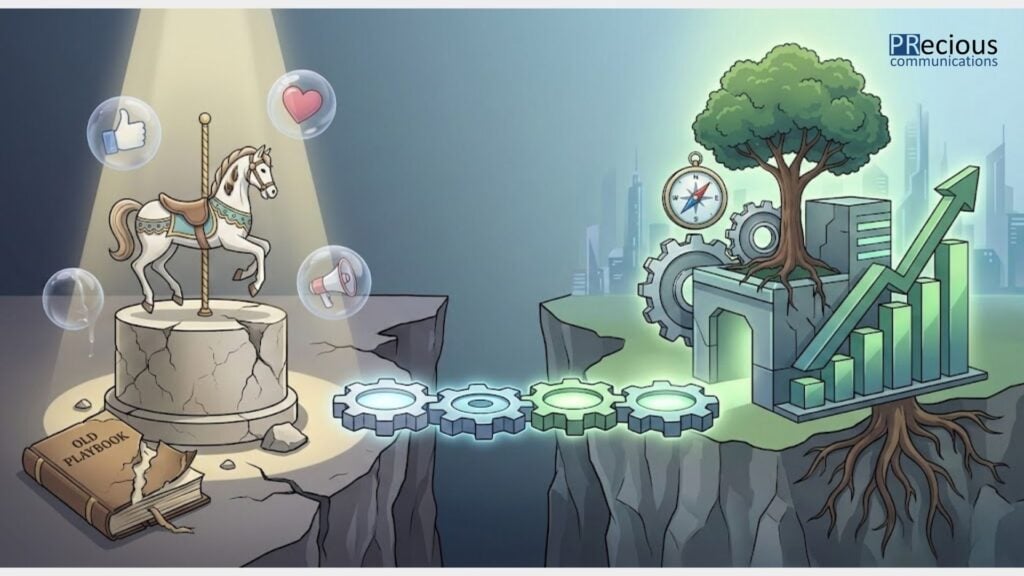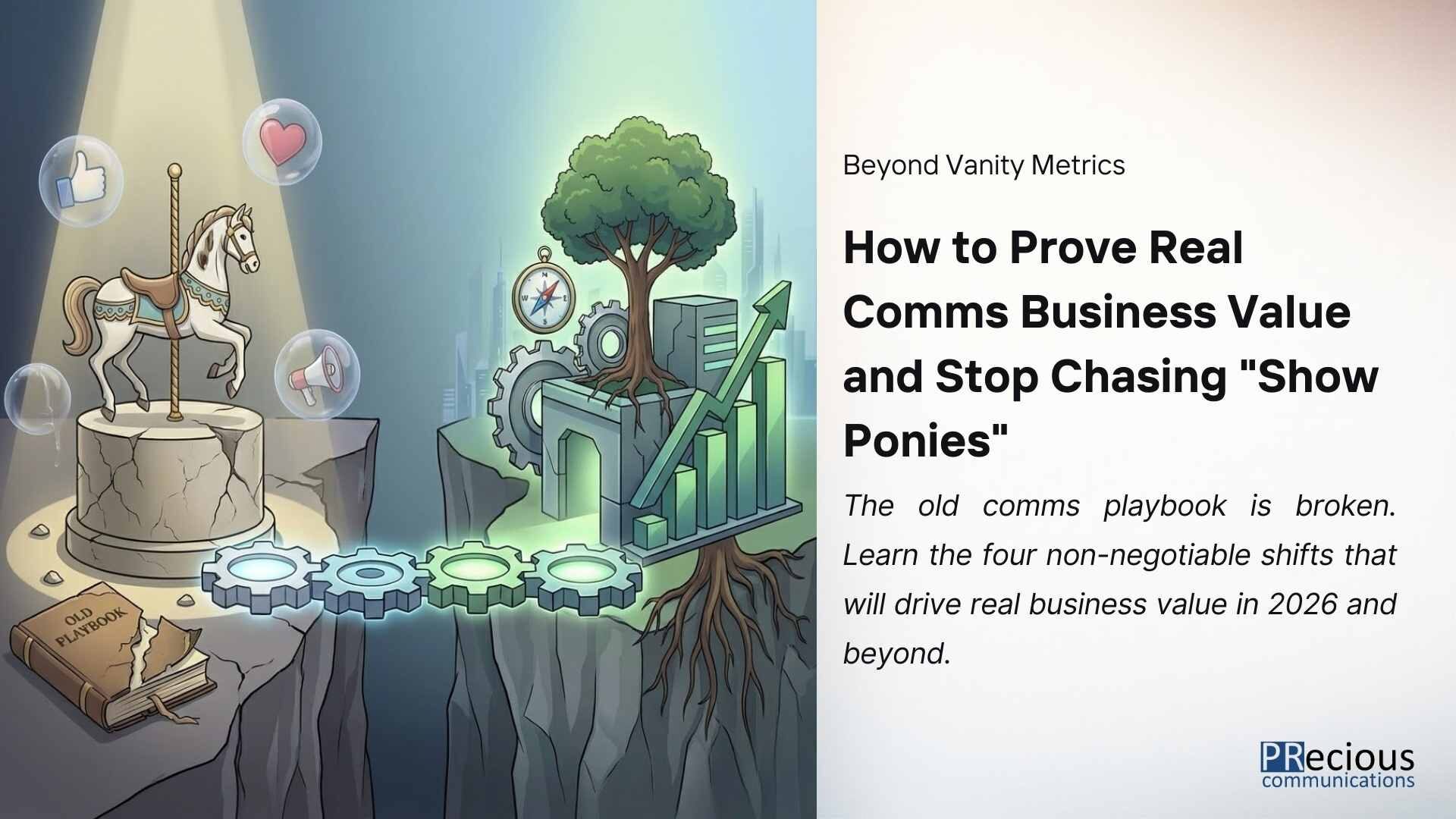In a recent conversation on the Earned First podcast, our founder Lars Voedisch sat down with Arun Sudhaman to discuss the massive, non-negotiable shifts facing the communications industry. The old playbook is broken. For years, the industry was rocked by digital fragmentation and a global pandemic. Now, generative AI is fundamentally reshaping business models from the ground up.
As Lars, a “true blood entrepreneur,” noted, “you’re never happy… you always see things that you should do better.” This drive to improve is now a survival imperative for our industry.
C-suite executives are no longer satisfied with PR reports focused on impressions and ad-value-equivalents (AVEs). They are asking harder, more fundamental questions: How did this campaign impact the sales funnel? How is this building a defensible brand? How is this driving business value?
The pressure is on. Recent PwC Pulse Surveys show a concerning trend: the number of CMOs who “strongly agree” that marketing’s value is understood by key decision-makers has plummeted. This mirrors a challenge comms leaders know all too well. As Arun and Lars discussed, comms leaders often have a “very lonely role,” caught between justifying budgets and proving their strategic worth to the board.
As a strategic communications consultancy, we believe this challenge presents the single greatest opportunity for our industry. It’s time to stop justifying our existence and start proving our value as a core driver of business.
Based on insights from our founder and CEO, Lars Voedisch, here is the new playbook for building a resilient, high-impact communications strategy for 2026 and beyond.

Move from Vanity to Value: Assemble Your “Navy SEALs” Team
This has been our core philosophy for 14 years. When Lars founded PRecious after leaving large agency networks, he was fascinated by the startup ecosystem: “very little resources, just driven by a vision.” He saw brilliant “engineers” and “coders” who were “really good at solving a very technical problem, but not necessarily the best in telling the story.” The “so what” was missing.
This is the new imperative: to adopt a business-first lens for every single action. This requires, as Lars says, “more brains than just hands.” The real value isn’t just in executing a campaign; it’s in having the business acumen to identify a “fundamental business problem” and deploy communications as the solution. As Lars noted, you can’t just put “icing on a cake that’s not… baked.”
To deliver this, the modern agency structure itself must change. We are moving away from rigid “traditional practices” and toward flexible “expertise areas.” As Lars explained, “How would you assign your Navy SEALs team for that… challenge? You might not need five snipers.” This agile model is a direct response to complex, multi-faceted business problems that don’t fit in a neat box. It allows us to assemble the right team of experts (in tech, corporate, or innovation) for a client’s specific business problem, rather than forcing them into a pre-built B2B or B2C structure.
Key Takeaway: Stop acting like a service provider and start acting like a strategic business partner. The future of comms lies in diagnosing business problems, not just fulfilling media requests. This requires an agile, expert-led team structure that is as flexible as the challenges it’s built to solve.
Use AI as Your Strategic Enabler, Not Just an Executor
The “AI temptation,” as Lars recently wrote on LinkedIn, is to “outsource your voice”—to use it as a shortcut for content and critical thinking. This, he argues, is a “race to the bottom” that leads to “bland,” commoditized content and a loss of the very soul of your brand.
In our podcast conversation, Lars noted that basic execution is “getting kind of eaten from the bottom” by AI. This is a good thing. It forces agencies and in-house teams to “move up the value chain” and focus on what humans do best: strategy, critical thinking, and building relationships.
The real value of AI isn’t replacing thought; it’s enhancing it. Smart leaders use AI to “augment… capabilities,” “enhance research,” “refine ideas,” and “analyze vast data sets,” not to “replace… critical thinking,” as Lars wrote. Lars described “having research at your fingertips” as “never easier,” but this research is just the starting point.
This frees up the “brains” to tackle the real strategic challenge of today’s fragmented landscape: bridging what Lars called the “thumb-stopping universe” of TikTok with the long-form, “GPT-powered content” that new search algorithms and LLMs demand. As he pointed out, these two worlds “don’t overlap much”—short videos don’t feed LLMs well. Human strategy is the only way to create a coherent brand narrative that works in both ecosystems.
Key Takeaway: AI doesn’t replace your strategy; it automates low-level tasks to free up your best minds for more complex strategic challenges. The biggest challenge? Creating a unified brand story that wins in both the short-form video and long-form AI search-driven worlds.
Double Down on Southeast Asia: The Global Growth Engine
During the podcast, Lars called Southeast Asia “my China.” It’s a reference to the region’s massive macroeconomic opportunity: a “young, digital savvy, mobile-first” population, high GDP growth, and its critical position at the “crossroads of supply chains.”
While other markets consolidate, Southeast Asia (SEA) is in a full-sprint growth phase. The latest e-Conomy SEA report from Google, Temasek, and Bain & Company confirms this, forecasting the region’s digital economy will surge past $300 billion in GMV by 2025. This isn’t just a “growth market”; it’s a foundational market for the next 20 years, especially as global trade continues to be “reshuffled.”
This is not a market to “wait and see.” It is the market that will define the next decade of global growth. It is a critical hub for innovation and a burgeoning consumer class. Furthermore, its workforce is “seizing the AI opportunity,” creating a uniquely dynamic and competitive landscape where brands must be present and active.
Key Takeaway: Southeast Asia is not just another “dot on the map” to add to a global plan. It is a uniquely fragmented, diverse, and high-growth engine that demands a dedicated, long-term, and deeply localized strategy of its own.
Win with an Adaptive ‘Glocal’ Playbook
You cannot win in Southeast Asia with a recycled plan. As Lars noted, you can’t simply “drop” a U.S. or China-centric road map onto a region this fragmented and diverse.
Lars, who previously worked at large agency networks, pointed out that the old model of “show ponies” pitching a one-size-fits-all solution is failing. Clients, he says, are “much smarter” and realize the global pitch team won’t be the “best there are in the Philippines” or “in Malaysia.” This is the why behind our “four-phase plan” for expansion:
- Start as a satellite: First, we execute in-market for existing clients.
- Build cross-border lanes: Next, we help local clients expand into neighboring countries.
- Go local-for-local: Only after establishing credibility and “boots on the ground” do we serve local brands in their home market.
- Earn the next step: The final phase is when a client trusts us to expand with them into new regions, as we did with Australia.
This methodical approach to scaling goes beyond the individual founder—it’s how you build a “PRecious brand, not a Lars brand” that can deliver consistent, high-quality, local insights.
This isn’t just a B2B trend; it’s a B2C reality. A 2024 report cited by ILS Translations found that 73% of global consumers expect companies to understand their unique needs and expectations. In SEA, this means adopting a hyper-local strategy that adapts to “culture, lifestyle, and even neighborhood-specific nuances” to build the “culture-based trust” that defines the market.
Key Takeaway: Trust is built locally, not imported. A successful “glocal” strategy is a sequential process of earning the right to operate in a market. It’s about proving your value, building local capability, and earning trust one step at a time, rather than just planting a flag.
Ready to Build Your 2026 Comms Playbook?
The future of communications is not about chasing impressions. It’s about being that trusted, entrepreneurial partner that can navigate uncertainty and deliver real, measurable business impact.
As Lars advises new founders, “Roll up your sleeves.” The first step is to “prove you can execute first” before you earn the right to strategize. That’s the mindset we bring to every partner.
Contact us today for a complimentary assessment of your 2026 communications strategy.
Our team of experts will help identify opportunities to optimize your budget for maximum impact in today’s complex information landscape.
Frequently Asked Questions (FAQ) about moving beyond vanity metrics in Comms
The fundamental shift is from focusing on output to focusing on outcome. The old playbook focused on vanity metrics and outputs like impressions, AVEs, and fulfilling media requests. The new imperative is to prove real business value by demonstrating how communications impacts the sales funnel, builds a defensible brand, and solves a fundamental business problem. This requires acting as a strategic partner, not just a service provider.
The “Navy SEALs” team is an agile, flexible model that moves away from rigid B2B or B2C traditional practices. Instead, it organizes experts around specific “expertise areas” (e.g., tech, corporate, innovation). This allows the agency to deploy the right team of specialists (“more brains than just hands”) to diagnose and solve a client’s complex, multi-faceted business problem, rather than forcing the problem into a pre-built structure.
This is the core strategic challenge that AI automates low-level tasks to free up human minds to solve. Short-form video (the “thumb-stopping universe” of platforms like TikTok) and long-form, “GPT-powered content” (needed for new search algorithms and LLMs) do not naturally overlap. A human-led, unified brand strategy is required to create a coherent narrative that successfully engages audiences in the short-form ecosystem while also building a comprehensive, searchable brand presence in the long-form, AI-driven world.
What is the recommended, sequential “Glocal” approach for establishing a presence in the Southeast Asia (SEA) market?
A successful “glocal” strategy in SEA is a methodical process of earning trust locally, not importing a global plan. This involves a four-phase expansion plan:
Start as a satellite: Execute in-market for existing clients to establish capability.
Build cross-border lanes: Help local clients expand into neighboring countries.
Go local-for-local: After establishing credibility, serve local brands in their home market.
Earn the next step: The client trusts you to expand with them into new, non-SEA regions.


